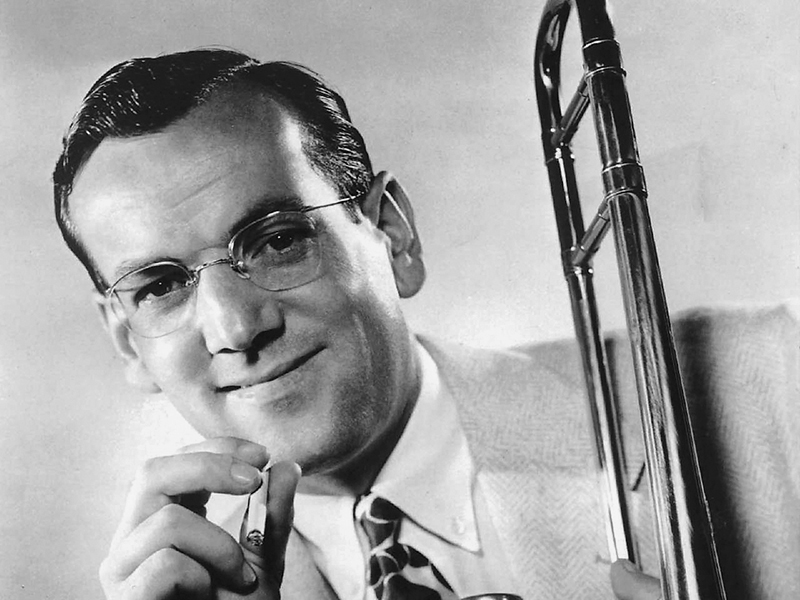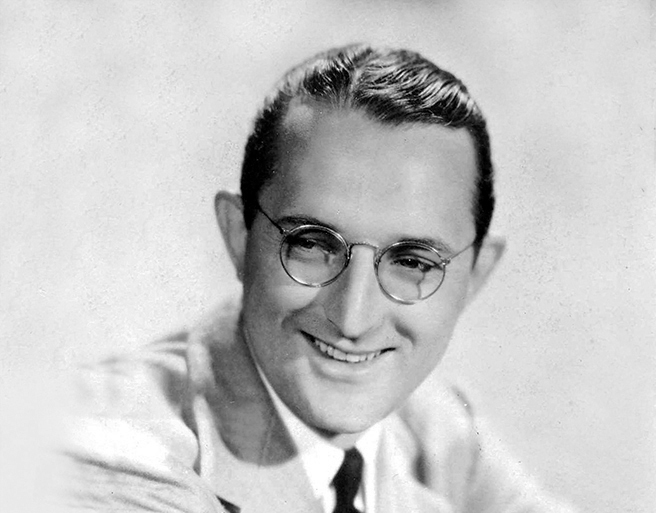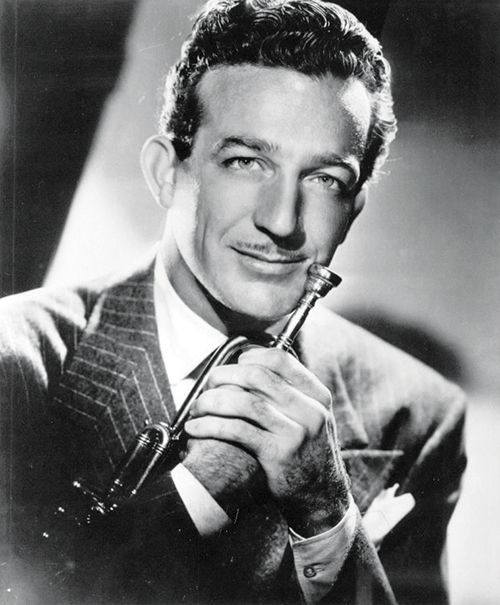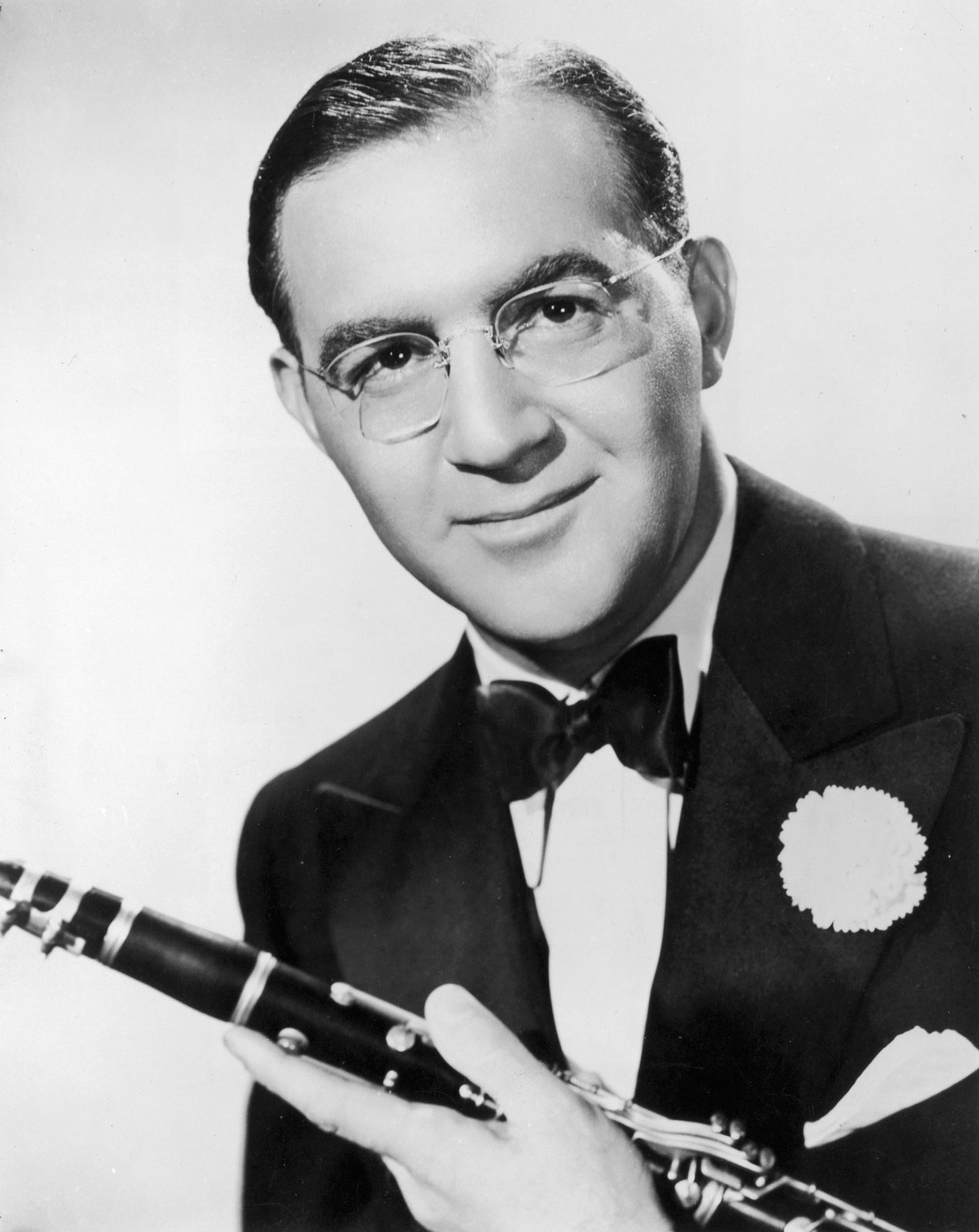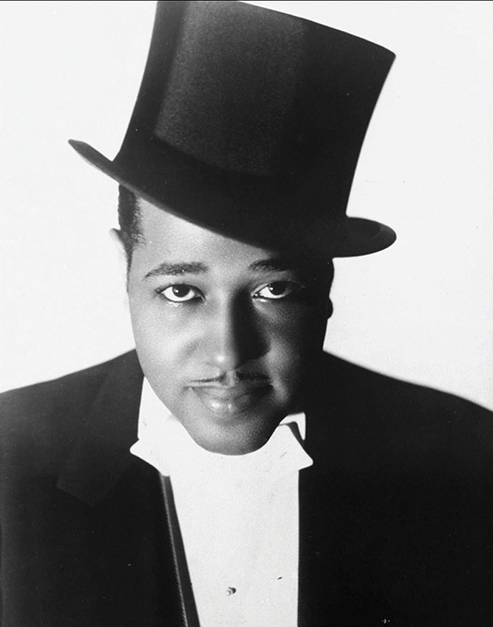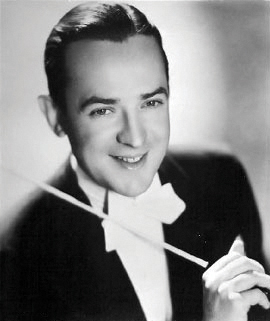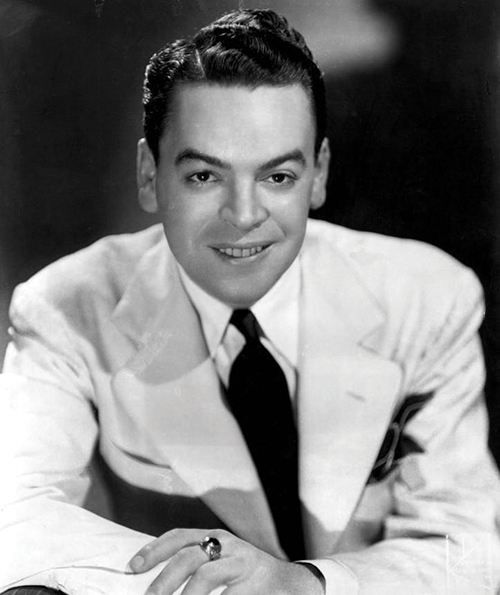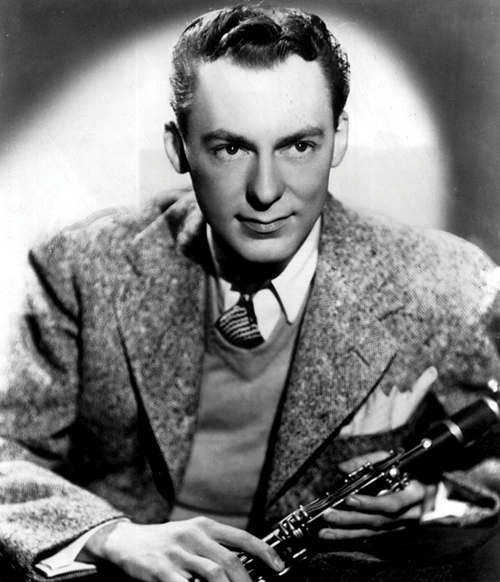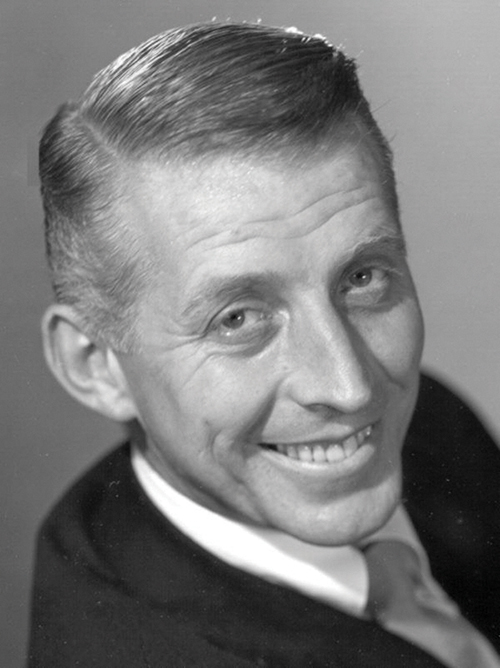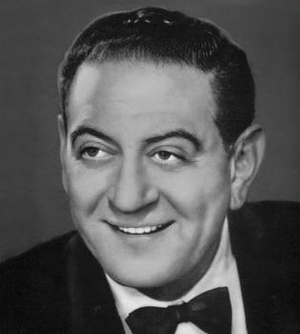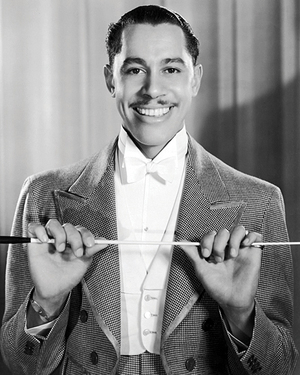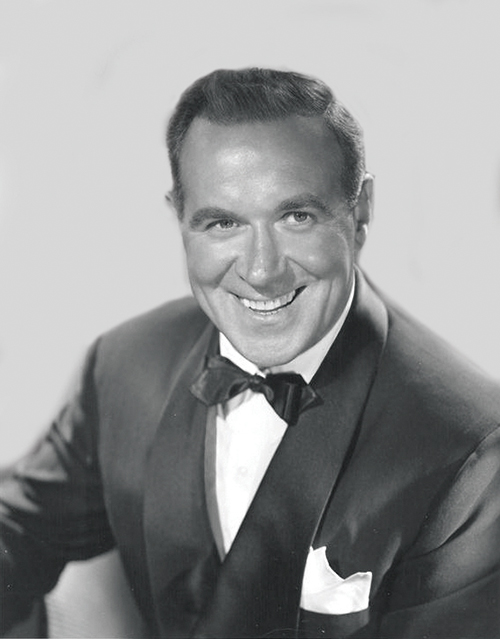















Music Overview
Music
SCROLL DOWN
Music Overview
Music
Meet the Big Band Masters

Glenn Miller
Glenn Miller
Glenn Miller
Glenn Miller
Glenn Miller
Bandleader of the Swing Era
Alton Glenn Miller was born March 1, 1904 in Clarinda, Iowa to Lewis Elmer Miller and Mattie Lou Cavender Miller. He was moved to Nebraska during his early formative years, then to Missouri where he bought his first trombone and finally his family moved to Colorado where he attended high school. By the time he graduated High School he had decided to become a professional musician.
In 1923 Glenn Miller attended college in Colorado, but couldn’t keep his interests focused in the books. He ended up dropping out of college to follow his musician dreams to become a Big Bandleader during the Swing era. By 1934 Glenn Miller had signed on with the Dorsey Brothers as the trombonist and arranger, but left them almost a year later to help organize a band for Ray Noble. In 1935 Glenn Miller was recording music under his own name like “Solo Hop” and by 1939 he had many other hits “Sunrise Serenade” “Moonlight Serenade” “Wishing (will make it so)” and “Over the Rainbow” to name of few chart toppers in his portfolio.
By 1942 Glenn Miller was organizing a service band for military functions performing live and by broadcast for the troops. Unfortunately Glenn Miller’s plane went missing December 15, 1944 over the English Channel on its way to Paris during WW II and he died at a young age of 40.

Tommy Dorsey
Tommy Dorsey
Tommy Dorsey
Tommy Dorsey
Tommy Dorsey
Trombonist and Big Band Leader
of the Swing Era
Thomas Francis Dorsey Jr. was born November 19, 1905 in the small town just northwest of Philadelphia called Shenandoah, Pennsylvania. He was born into a musical family with his father Thomas Dorsey Sr. and older brother Jimmy Dorsey also being bandleaders. Tommy Dorsey Jr. began playing the trumpet as a child, but later found a love for the trombone.
In the early 1920s Tommy was 15 years old and his brother Jimmy felt that he was a good fit as a trombonist to start joining the bands that Jimmy was part of. The brothers played many years together in bands such as The Scranton Sirens, Jean Goldkette’s Band, and the California Ramblers they eventually created the The Dorsey Brothers. In 1934 they signed a record deal with Decca Records and great performers like Glenn Miller and Frank Sinatra joined with The Dorsey Brothers to create great many American classics during the swing era.
In 1935 Tommy Dorsey decided to go it on his own and split away from his brother and their band. He evolved his own band yearly by acquiring any musician on his path that he felt worthy of greatness which fueled his success. Tommy was also a savvy businessman in the music industry and he lent Glenn Miller the money he needed to start the Glenn Miller Band. Tommy Dorsey’s musical career was triumphant with over 286 billboard chart hits and of those 36 were on the top of the charts. His musical career spanned over four decades. Unfortunately the great Tommy Dorsey passed away in his sleep November 26, 1956 at the young age of 51.

Harry James
Harry James
Harry James
Harry James
Harry James
“The Hawk”
Harry Haag James was a professional American Jazz musician, conductor, songwriter, and trumpet player of the Big Band era. He was born in Albany, Georgia in 1916 and by the young age of 8 years old he’d already learned to play the trumpet. He was a son of a bandleader who was in a traveling circus called the Haag Circus, where his mother was an acrobat and horseback rider. He soon became one of the most admired jazz players during the big band era. During the 1940s Harry James’ music was so well liked that record companies couldn’t keep up with the demand for his music.
Harry James was also an actor during the 1950s, but many of his roles featured him being in the music industry or he had written music for the movies that he acted in. He was married 3 times during his life. His first wife was Lousie Tobin a singer, his second wife was famous actress Betty Grable, and his third wife was a Las Vegas showgirl Joan Boyd. He had 5 children and by the time he had passed away July 5, 1983 he had 16 grandchildren. Frank Sinatra gave the eulogy at Harry James’ funeral.

Benny Goodman
Benny Goodman
Benny Goodman
Benny Goodman
Benny Goodman
“King of Swing”
Goodman was born in Chicago, the ninth of twelve children of poor Jewish emigrants from the Russian Empire. Money was a constant problem in the family. Benny’s father earned at most $20 per week. On Sundays, his father took the children to free band concerts in Douglas Park, which was the first time Benny experienced live professional performances. To give his children some skills and an appreciation for music, his father enrolled ten-year-old Benny and two of his brothers in music lessons at the Kehelah Jacob Synagogue, which charged his father only 25¢ per lesson, including the use of the synagogue’s instruments.
Goodman made his professional debut in 1921 at the Central Park Theater on Chicago’s West Side. He entered Harrison High School in Chicago in 1922. He joined the musicians’ union in 1923 and by the age of 14 was in a band featuring Bix Beiderbecke. Goodman attended Lewis Institute (now Illinois Institute of Technology) in 1924 as a high-school sophomore, while also playing the clarinet in a dance hall band. When Goodman was 16, he joined one of Chicago’s top bands, the Ben Pollack Orchestra, with which he made his first recordings in 1926. Goodman made his first record under his own name for Vocalion two years later. He recorded with the regular Pollack band and smaller groups drawn from the orchestra through 1929. The side sessions produced scores of sides recorded for the various dimestore record labels under an array of group names, including Mills’ Musical Clowns, Goody’s Good Timers, the Hotsy Totsy Gang, Jimmy Backen’s Toe Ticklers, Dixie Daisies, and Kentucky Grasshoppers.
After winning numerous polls over the years as best jazz clarinetist, Goodman was inducted into the Down Beat Jazz Hall of Fame in 1957. He continued to play on records and in small groups. In the early 1970s he collaborated with George Benson after the two met taping a PBS salute to John Hammond, recreating some of Goodman’s famous duets with Charlie Christian.

Artie Shaw
Artie Shaw
Artie Shaw
Artie Shaw
Artie Shaw
“The King of the Clarinet”
Arthur Jacob Arshawsky was born May 23, 1910 in New York City, NY. The famous “King of the Clarinet” was widely known for being an American composer, and bandleader, but he was also a fiction and non-fiction writer during his time. He served in the US Navy from 1942 to 1944 leading a morale-building band throughout the South Pacific for the troops during World War II. Throughout his life he was married 8 times and self-proclaims that he was a difficult man to be around. Artie Shaw retired from music completely by 1954 to pursue his writing career. Artie Shaw passed away December 30, 2004.

Duke Ellington
Duke Ellington
Duke Ellington
Duke Ellington
Duke Ellington
Duke the Great American Composer, Pianist, and Bandleader Spanning 50 Musical Years of his Life
Edward Kennedy “Duke” Ellington was born in Washington, D.C. April 29, 1899. Both of his parents were pianists. He became an American composer, bandleader of jazz orchestras, and pianist. Ellington wrote more than one thousand compositions. Before he was famous his mother surrounded herself with dignified women, so Ellington would grow up learning proper etiquette. It seemed to work, because the childhood friends Ellington had noticed his noble like dress and behavior and started calling him “Duke” Ellington. Duke Ellington won the special Pulitzer Prize after he had passed away in 1999. Duke Ellington married his high school sweetheart July 2, 1918 and they had one son, Mercer Kennedy Ellington, March 11, 1919. They permantely separated in the late 1920s and in 1928 Ellington took a companion named Mildred Dixon who inspired much of his musical career. About ten years later he left his family and pursued relationships with a few other women over the upcoming years of his life. Duke Ellington died on May 24, 1974 from complications from lung cancer and pneumonia.

Jimmy Dorsey
Jimmy Dorsey
Jimmy Dorsey
Jimmy Dorsey
Jimmy Dorsey
A Great American Jazz Clarinetist, Saxophonist, Trumpeter, Composer and Big BandLeader of the Swing Jazz Era
James “Jimmy” Dorsey was born in Shenandoah, Pennsylvania February 29, 1904. Jimmy Dorsey was the older brother of Tommy Dorsey who was also a famous musician in the big band era. The brothers played together in the beginning years of their musical careers in bands like the Dorsey Brothers Orchestra, which was later changed to Jimmy Dorsey Orchestra. Jimmy continued leading his own band until early 1950s. Jimmy passed away June 12, 1957 soon after his younger brother Tommy Dorsey who died November 26, 1956.

Les Brown
Les Brown
Les Brown
Les Brown
Les Brown
American Clarinetist, Saxophonist, Composer and Big Band Leader of the Jazz Swing Era
Lester Raymond “Les” Brown, Sr. was born March 14, 1912 in Reinerton, Pennsylvania. Les Brown attended Duke University from 1932-1936 where he led the group Les Brown and His Blues Devils. He left Duke with a few of his band members in 1936 and by 1938 the band rebranded themselves as the Band of Renown. Les Brown was married one time and had his son Les Jr. and a daughter Denise. Les Brown passed away in 2001 at 88 years old of lung cancer. Les Brown was inducted into the North Carolina Music Hall of Fame in 2010. Les Brown’s son Les Brown Jr became the leader of the Band of Renown in 2001 and they continue to perform around the world.

Woody Herman
Woody Herman
Woody Herman
Woody Herman
Woody Herman
“The Road Father”
Woodrow Charles “Woody” Herman was born May 16, 1913 in Milwaukee, Wisconsin. He was a famous big band leader, American jazz clarinetist, alto and soprano saxophonist, and singer. His father Otto was a big influence in his early years of childhood, because Otto was in love with show business. Woody started his career as a young child singing and tap-dancing and by the time he was 12 years old he began playing clarinet and saxophone. By 1944, he had the band the First Herd. The First Herd was famous for their progressive jazz, which was heavily influenced by other famous jazz musicians Duke Ellington and Count Basie.
His most successful band Herman Band was forced to disband in 1946 and this was Herman’s only financially successful band. He left his band to be supportive of his wife and family while his wife, Charlotte Nestle who was struggling with alcoholism and pill addictions. Fans and Critics have said that the big band era ended in December 1946 when Herman’s band and seven other bands disbanded. Herman created in 1947 the Second Herd band and in the 1950s the Third Herd Band. The Third Herd had a successful tour in Europe. By the 1960s he was famous for hiring many young but stellar up incoming musicians for his Herd Bands.
By the end of the 60s his music library was heavily influenced by rock and roll. He featured brass and woodwind instruments that before this time were not associated with jazz music. Into the 1970s Herman began spreading his knowledge of music through jazz education, which eventually leant him the name as “Road Father.” He kept performing into the 1980s and he was awarded the Grammy Lifetime achievement award in 1987. Herman passed away October 29, 1987.

Stan Kenton
Stan Kenton
Stan Kenton
Stan Kenton
Stan Kenton
Pianist, Composer, Arranger, Educator, and Innovator of Controversial American Jazz
Stanley Newcomb “Stan” Kenton was born December 15 1911 in Wichita, Kansas; although, his parents who conceived him out of wedlock told everyone he was born February 19, 1912, to hide their secret. Oddly enough Kenton didn’t know the truth of his actual birth year until he was well into his adult life. He allowed his parents to keep their dignity and his grave stone was later availed with the wrong birthdate to preserve his parents secret.
Stan Kenton learned to play the piano while he was a young child and began touring with many different bands as a teenager. He formed his own band in 1941 and his band and style was known as “The Wall of Sound.” By the mid-60s he dove into his interests with teaching progressive jazz education and sparked big band interests in high schools and colleges. Kenton toured with his bands all the way into the late 1970s. Kenton died of a stroke August 25, 1979.

Guy Lombardo
Guy Lombardo
Guy Lombardo
Guy Lombardo
Guy Lombardo
“Mr. New Year’s Eve”
Gaetano Alberto “Guy” Lombardo who was a famous band leader and violinist was born June 19, 1902 in London, Ontario. His parents were Italian-Canadian immigrants. His father encouraged four of his five sons to play instruments, so he could have them play with him while he sang. The four brothers formed their first orchestra together while they were in elementary school. By 1938, Lombardo became a naturalized citizen of the United States. Guy Lombardo or “Mr. New Year’s Eve” is most remembered for 50 years of New Year’s Eve big band remotes, which first started on the radio and later were televised. Other pursuits included hydroplane speedboat racing, which he won a Gold Cup in 1946 for. In 2002, he was inducted into the Canadian Motorsport Hall of Fame.

Cab Calloway
Cab Calloway
Cab Calloway
Cab Calloway
Cab Calloway
“The Hi-Di-Ho Man”
Cabell “Cab” Calloway III was born in Rochester, New York December 25, 1907. Calloway comes from very well educated parents. His mother Martha Eulalia Reed, was a Morgan State College graduate. His father Cabell Calloway Jr. was a graduate of Lincoln University of Pennsylvania and by 1989 his father worked as a Lawyer and did real estate. Cab Calloway III grew up in a middle-class home. His parents recognized his vocal talents and put him into voice lessons in 1922. Surprisingly, his parents disapproved of jazz, but Calloway went against their wishes and began performing in many Baltimore nightclubs. After high school Calloway went on touring with his older sister, Blanche. His sister became an accomplished bandleader before her brother did, and throughout his life he would acknowledge his sister as his inspiration for his own success. His father had hoped that he would follow in his footsteps and become a lawyer, so being a good son he registered into Crane College, but his heart was wrapped around music. He became an understudy to singer Adelaide Hall and he met Louis Armstrong who taught him to sing in the “scat” style. He didn’t last in college and followed his own dreams by leaving to sing in a band called Alabamians. He later became a successful bandleader of his own orchestra. Calloway and Duke Ellington were known for breaking the major broadcast network color barrier in their time. After a long lived successful musical career Calloway suffered a severe stroke and passed away November 18, 1994, at the age of 86.

Russ Morgan
Russ Morgan
Russ Morgan
Russ Morgan
Russ Morgan
Bandleader, One of the Top Trombonist and Pianist, One of the Most Accomplished Composer-Arrangers of his Time
Russ Morgan was born April 29, 1904 in Scranton, Pennsylvania. Russ was a big band orchestra leader, pianist, trombonist, composer, and musical arranger. Morgan was encouraged by his parents at the young age of 7 to pursue his musical interests. His father had played the drums when he wasn’t working in a coal mine and his mother was a pianist. Morgan began playing in a local band, The Scranton Sirens, which was popular during the 1920s in Pennsylvania. The Scranton Sirens relinquished quite a few magnificent artists into the world of music. Such names as, Tommy Dorsey the famous trombonist and big band leader, Billy Lustig a violinist, and older Dorsey brother Jimmy on the saxophone.
Morgan’s greatest success was when he was offered the position of Musical Director for Detroit Radio Station WXYZ. He had an extremely popular radio show called “Music in the Morgan Manner.” He stayed successful into the 1950s with his orchestra playing popular music for listening and dancing, they called these bands “sweet bands.” Morgan passed away August 7, 1969 in Las Vegas, Nevada at the age of 65. Russ Morgan holds a Hollywood star in L.A. for his contributions to recording.

The Andrews Sisters
The Andrews Sisters
The Andrews Sisters
The Andrews Sisters

